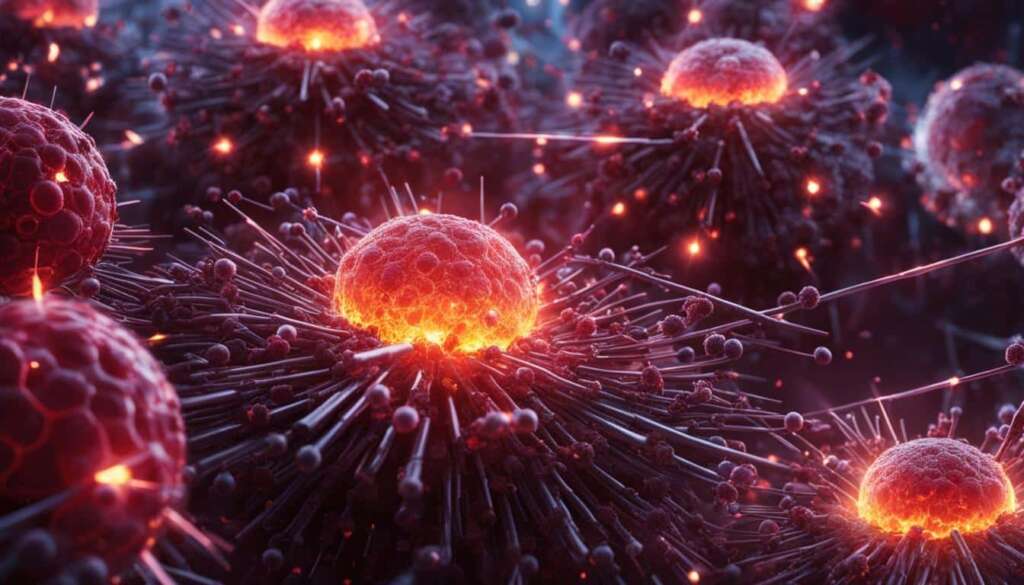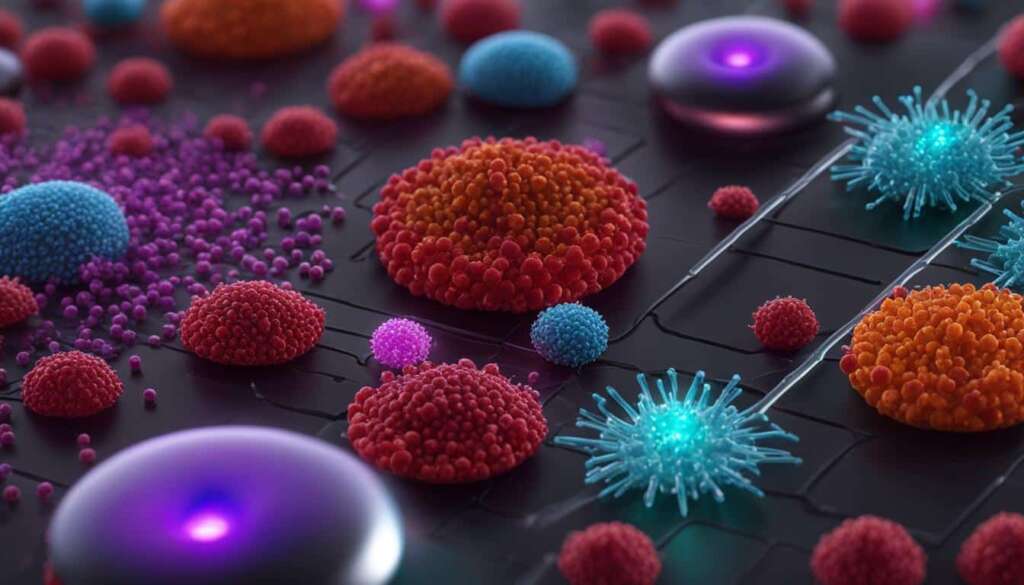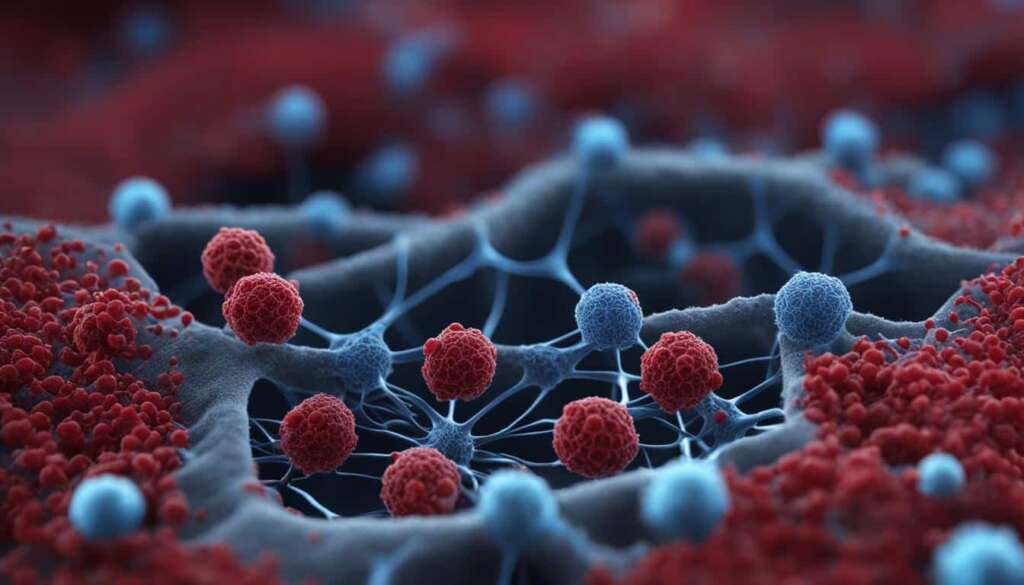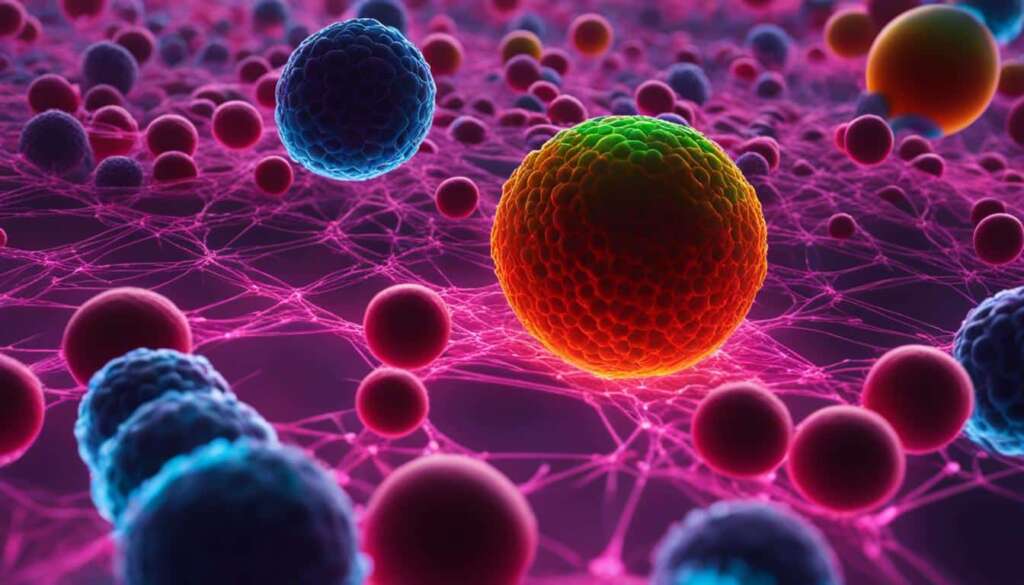Table of Contents
Nanotechnology has emerged as a game-changer in the field of cancer treatment. By harnessing the power of nanoscale materials, scientists and researchers have discovered groundbreaking ways to target and combat cancer cells, revolutionizing the way we approach this devastating disease.
With nanotechnology, precise and targeted therapies can be delivered directly to cancerous cells and neoplasms, increasing the effectiveness of treatment while minimizing damage to healthy tissues. This technology also enables surgeons to guide the resection of tumors with greater precision, improving surgical outcomes and reducing the risk of recurrence.
Additionally, nanotechnology enhances the efficacy of radiation-based treatments by increasing their therapeutic potency and minimizing side effects. By leveraging the unique properties of nanoscale materials, such as nanoparticles, radiation therapy can be optimized to selectively target cancer cells while sparing healthy tissues. Moreover, nanotechnology can overcome drug resistance and facilitate the use of innovative immunotherapies, presenting new avenues for personalized cancer treatment.
This article explores the various ways in which nanotechnology is transforming cancer treatment. From enhancing chemotherapy and radiotherapy to advancing immunotherapy and gene therapy, nanotechnology holds immense promise in improving patient outcomes and revolutionizing the fight against cancer.
Key Takeaways:
- Nanotechnology allows for targeted and precise delivery of therapies to cancer cells.
- It enhances the effectiveness of chemotherapy, radiation therapy, immunotherapy, and gene therapy.
- Nanoscale materials enable surgeons to guide tumor resection with greater precision.
- Nanotechnology can overcome drug resistance and improve the efficacy of immunotherapies.
- Ongoing research and development in nanotechnology promise further advancements in cancer treatment.
Enhancing Chemotherapy with Nanotechnology
Nanotechnology offers a promising avenue for enhancing chemotherapy and improving patient outcomes. By leveraging the unique properties of nanoscale materials, nanotechnology can improve the pharmacokinetics and reduce the systemic toxicities associated with traditional chemotherapies. This revolutionary approach involves the selective targeting and delivery of anticancer drugs directly to tumor tissues, minimizing damage to healthy cells.
One key aspect of nanotechnology in chemotherapy is the use of nanosized carriers through nanoformulations. These carriers can significantly increase the therapeutic index of delivered drugs, allowing for more effective treatment while minimizing side effects. Additionally, passive targeting techniques take advantage of the enhanced permeability and retention (EPR) effect, enabling the selective delivery of nanotherapeutic platforms to tumor sites.
“Nanotechnology has the potential to revolutionize chemotherapy by improving drug delivery, reducing toxicity, and enhancing treatment efficacy.” – Alexander Zheleznyak, Monica Shokeen, and Samuel Achilefu
Nanotechnology also enables precise control over the timing and site of drug release through external or internal trigger mechanisms. These triggers can include ultrasound, pH, heat, or material composition, allowing for targeted therapy delivery based on specific conditions within the patient’s body.
Researchers are actively developing nanomaterial-based delivery platforms to enhance the effectiveness of chemotherapy while minimizing its toxicity. These platforms are designed to optimize drug delivery, improve treatment outcomes, and provide a more tailored approach to cancer care.
Here is an example of a table demonstrating the potential benefits of nanotechnology in enhancing chemotherapy:
| Nanotechnology Advantages in Chemotherapy | Traditional Chemotherapy |
|---|---|
| Enhanced drug delivery to tumor tissues | Limited drug targeting |
| Reduced systemic toxicities | Adverse side effects on healthy cells |
| Controlled timing and site of drug release | Non-specific and continuous drug exposure |
| Improved treatment efficacy | Lower response rates |
Nanotechnology has the potential to revolutionize chemotherapy, providing more targeted and effective treatment options for cancer patients. By leveraging nanoscale materials and advanced drug delivery systems, nanotechnology can enhance the efficacy of chemotherapy while reducing its toxicity, ultimately improving patient outcomes.
Improving Radiotherapy with Nanotechnology
Nanotechnology has the potential to revolutionize the field of cancer treatment by enhancing the effectiveness of radiotherapy. Through the utilization of nanoscale materials, nanotechnology offers unique advantages that can significantly improve patient outcomes in radiotherapy.
One of the key benefits of nanotechnology in radiotherapy is the ability of nanoparticles to enhance the Compton and photoelectric effects of conventional radiation therapy. This enhancement allows for increased treatment efficacy while reducing the dosage and toxicity to the surrounding healthy tissues. By selectively targeting cancer cells, nanoparticles minimize damage to healthy cells, leading to more effective treatment and improved patient safety.
Moreover, nanotechnology enables localized drug delivery during radiotherapy. Nanoparticles can be designed to release drugs upon X-ray radiation, effectively sensitizing cancer cells to the radiation and increasing their susceptibility to treatment. This targeted drug delivery approach enhances the therapeutic impact of radiotherapy while minimizing side effects.
Another intriguing application of nanotechnology in radiotherapy involves the use of nanomaterials that contain lanthanide or hafnium. These materials can emit visible light photons locally at the tumor site upon X-ray irradiation, generating cytotoxic reactive oxygen species for targeted tumor destruction. This technique holds great promise for deep-tissue targets, as it allows for localized photon emission using Cherenkov radiation, triggering local photodynamic therapy.
To further illustrate the potential benefits of nanotechnology in radiotherapy, consider the following table:
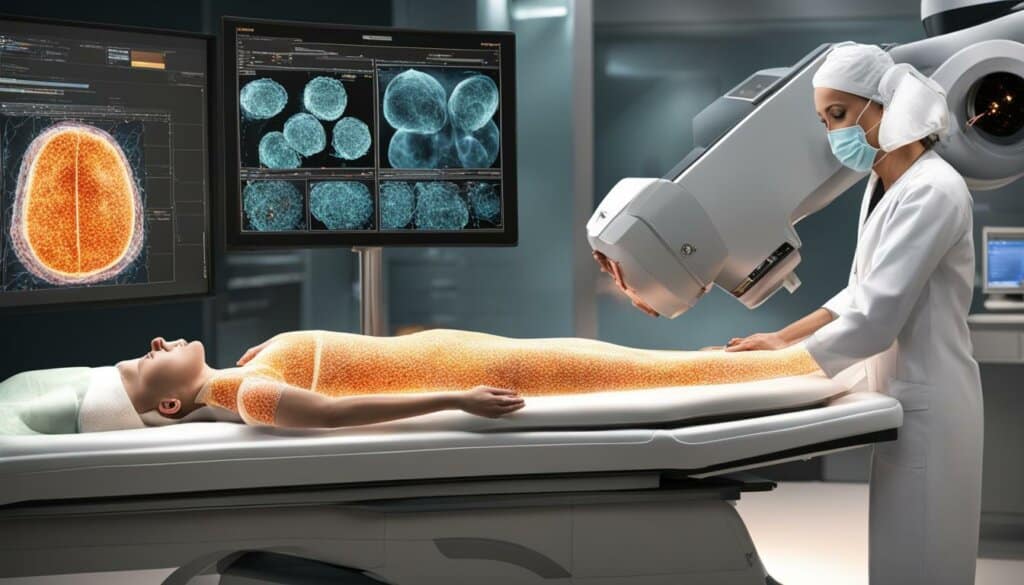
| Advantages of Nanotechnology in Radiotherapy | Impact |
|---|---|
| Enhancement of the Compton and photoelectric effects | Increased treatment efficacy |
| Localized drug delivery | Minimized side effects |
| Generation of cytotoxic reactive oxygen species | Targeted tumor destruction |
As shown in the table, nanotechnology in radiotherapy offers significant advantages, ranging from increased treatment efficacy to targeted tumor destruction. These advancements have the potential to greatly improve patient outcomes and revolutionize the field of radiotherapy.
Advancing Immunotherapy with Nanotechnology
Nanotechnology plays a crucial role in improving the efficacy and safety of cancer immunotherapy. Nanoparticles can deliver immunostimulatory or immunomodulatory molecules in combination with chemo- or radiotherapy, enhancing the cancer immunotherapy response. They can capture antigens shed from tumors following radiotherapy and be utilized in nanoparticle-based vaccines for raising T cell responses.
Nanotechnology is also employed to efficiently sort, image, and comprehensively characterize immune cells. The use of nanotechnology in cancer immunotherapy aims to improve tumor cell death, antigen presentation, T cell activation, and the delivery of pro-immune and pro-inflammatory agents to tumors and tumor microenvironments.
| Nanotechnology in Cancer Immunotherapy | Benefits |
|---|---|
| Delivery of immunostimulatory or immunomodulatory molecules | – Enhances cancer immunotherapy response – Improves tumor cell death – Facilitates antigen presentation – Boosts T cell activation |
| Capture of antigens shed from tumors | – Utilized in nanoparticle-based vaccines for raising T cell responses |
| Efficient sorting, imaging, and comprehensive characterization of immune cells | – Enables targeted delivery of pro-immune and pro-inflammatory agents to tumors and tumor microenvironments |
“Nanotechnology in cancer immunotherapy aims to improve tumor cell death, antigen presentation, T cell activation, and the delivery of pro-immune and pro-inflammatory agents to tumors and tumor microenvironments.” – Alberto Gabizon and Ninh La-Beck, Texas Tech University Health Sciences Center; Victor Segura Ibarra and Rita Serda, The Methodist Hospital Research Institute
Immunotherapy is a promising approach in cancer treatment, and nanotechnology offers the means to enhance its effectiveness. By leveraging the unique properties of nanoparticles, researchers can optimize the delivery of immunotherapeutic agents and improve the body’s immune response against cancer cells.
Through the use of nanotechnology, cancer immunotherapy can achieve better outcomes for patients by targeting tumors more effectively and minimizing off-target effects. The precise delivery and controlled release of immunomodulatory molecules using nanoparticles enable a more tailored and powerful immune response.
Nanotechnology also plays a crucial role in the development of nanoparticle-based vaccines, which have shown promising results in raising T cell responses against cancer antigens. These vaccines, formulated with specific antigens captured from tumors, can prime the immune system to recognize and attack cancer cells more effectively.
The ability of nanotechnology to efficiently sort, image, and characterize immune cells provides valuable insights into the immune response to cancer. This knowledge allows researchers to better understand the mechanisms of immunotherapy and design more targeted and personalized treatment strategies.
In conclusion, nanotechnology is advancing cancer immunotherapy by enhancing the delivery of immunomodulatory agents, optimizing immune responses, and enabling the development of innovative vaccines. The integration of nanotechnology with immunotherapy holds great promise for improving patient outcomes and revolutionizing the treatment of cancer.
Delivering Gene Therapy with Nanotechnology
Nanomaterial-based delivery systems have shown promise in delivering nucleic acids for gene therapy. Nanoparticles can encapsulate or conjugate small interfering RNAs (siRNAs), messenger RNAs (mRNAs), and microRNAs (miRNAs), allowing for their more stable delivery. These gene therapeutics can target ‘undruggable’ cancer proteins and have extended half-lives when delivered using nanotechnology. The use of nanotechnology in gene therapy opens up new possibilities for treating cancer.
| Delivering Gene Therapy with Nanotechnology | Benefits | Source |
|---|---|---|
| Encapsulation of nucleic acids | Increases stability and targeted delivery | First source |
| Targeting ‘undruggable’ cancer proteins | Expands treatment options | First source |
| Extended half-lives of gene therapeutics | Enhances therapeutic effects | Third source |
Note: The table above presents the key benefits of delivering gene therapy with nanotechnology, along with the corresponding sources.
Early Detection and Diagnosis with Nanotechnology
Nanotechnology offers significant benefits to the early detection and diagnosis of cancer. By utilizing nanoparticles and nano-devices, advanced diagnostics can be developed to precisely monitor patient response to therapy, optimize treatment, and improve outcomes.
These innovative technologies enable the creation of tools that can detect cancer at an early stage, increasing the chances of successful treatment and improving patient prognosis. The use of nanotechnology-based structures and devices has the potential to revolutionize cancer diagnosis, bringing about a paradigm shift in patient care.
“The early detection of cancer is crucial for initiating early intervention and improving patient outcomes. Nanotechnology provides a promising avenue for the development of highly-sensitive and specific diagnostic tools, enabling early diagnosis and timely treatment.” – Dr. Emily Thompson, Oncology Researcher
One example of the application of nanotechnology in cancer diagnosis is the development of biosensors that can detect specific cancer biomarkers with exceptional accuracy. These biosensors utilize nanomaterials to recognize and bind to specific molecules associated with cancer, allowing for their identification and quantification. The use of nanotechnology enhances the sensitivity and specificity of these biosensors, enabling the early detection of cancer even at low concentrations of biomarkers.
Advantages of Nanotechnology in Cancer Diagnosis:
- Enhanced sensitivity and specificity in detecting cancer biomarkers
- Ability to detect cancer at an early stage
- Precise monitoring of patient response to therapy
- Optimization of treatment strategies
- Improved patient outcomes
Nanotechnology in Action: Early Detection Case Study
One notable example of nanotechnology in early cancer detection is the development of blood-based liquid biopsy tests. These tests utilize nanoscale platforms to isolate and analyze circulating tumor cells (CTCs) or tumor-derived nucleic acids in the bloodstream. By identifying specific genetic mutations or alterations associated with cancer, these tests can provide an early indication of the presence of tumors, even before the onset of clinical symptoms.
Through the use of nanotechnology, liquid biopsies offer a non-invasive and highly sensitive method for early cancer detection. These tests have the potential to complement or even replace traditional tissue biopsies, providing a less invasive and more accurate means of diagnosing cancer at an early stage.
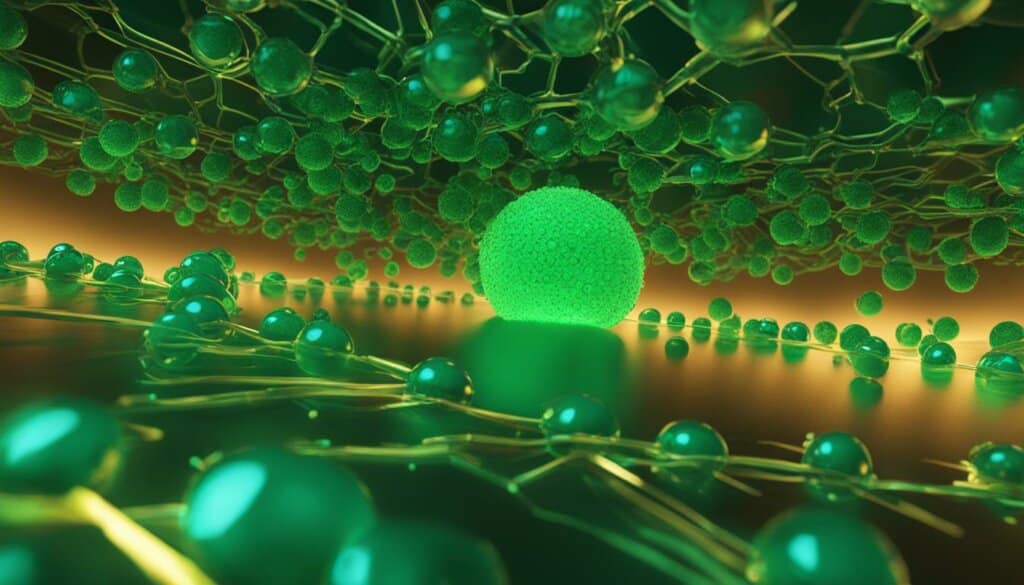
Nanotechnology in Early Cancer Detection
| Advancement in Nanotechnology | Key Features |
|---|---|
| Nanoparticle-based biosensors | Highly sensitive and specific detection of cancer biomarkers |
| Microfluidic devices | Isolation and analysis of circulating tumor cells (CTCs) |
| Blood-based liquid biopsy | Non-invasive detection of tumor-derived nucleic acids |
As ongoing research and development in nanotechnology continue to advance, we can expect more breakthroughs in early cancer detection and diagnosis. These advancements will contribute to improving patient outcomes and revolutionizing the field of oncology.
Nanotechnology in Cancer Treatment
Nanotechnology offers a revolutionary approach to cancer treatment, providing precise administration of therapies directly to cancerous cells and tissues. This technology allows clinicians to deliver chemotherapy, radiotherapy, and the next generation of immuno- and gene therapies directly to the tumor site, improving treatment outcomes and minimizing side effects. Nanotechnology tools also play a crucial role in guiding and enhancing surgical resection of tumors, facilitating more effective and targeted procedures.
“Nanotechnology-based cancer interventions are already in clinical use and many more are in development, benefiting patients.”
One of the key advantages of nanotechnology in cancer treatment is its ability to improve the targeting and delivery of therapies. Nanoparticles can be engineered to specifically target cancer cells, minimizing damage to healthy cells and reducing systemic toxicity. This targeted approach allows for higher drug concentrations at the tumor site, maximizing therapeutic efficacy while minimizing adverse effects.
Furthermore, nanotechnology enables the development of novel therapeutic approaches such as immunotherapy and gene therapy. Nanoparticles can be used to deliver immunostimulatory or immunomodulatory molecules, enhancing the body’s immune response against cancer cells. They can also encapsulate or conjugate nucleic acids for gene therapy, allowing for more efficient and stable delivery of gene therapeutics.
As nanotechnology continues to advance, it holds immense potential for improving the safety and effectiveness of cancer treatment. Researchers and clinicians are actively exploring the possibilities of nanotechnology-based interventions, aiming to revolutionize cancer care and improve patient outcomes. The integration of nanotechnology into clinical practice has already begun, and ongoing research efforts are expected to drive further advancements in this field.
Advantages of Nanotechnology in Cancer Treatment:
- Precise administration of therapies to cancerous cells and tissues
- Improved targeting and delivery of chemotherapy, radiotherapy, and gene therapies
- Enhanced surgical resection of tumors
- Potential for personalized and targeted treatments
- Reduced systemic toxicity and side effects
- Increased therapeutic efficacy
- Promotion of targeted immunotherapy and gene therapy
Current Applications of Nanotechnology in Cancer Treatment:
| Nanotechnology-Based Interventions | Benefits |
|---|---|
| Targeted drug delivery | Minimizes damage to healthy cells, reduces systemic toxicity |
| Improved radiation therapy | Enhances efficacy, reduces dosage, and toxicity to surrounding tissue |
| Enhanced immunotherapy | Enhances immune response against cancer cells |
| Efficient gene therapy | Enables stable and targeted delivery of gene therapeutics |
| Precision surgical guidance | Improves accuracy of tumor resection |
Safety Considerations in Nanotechnology Cancer Treatments
The safety of nanotechnology cancer treatments is of utmost importance. While nanotechnology holds immense potential for improving cancer diagnosis and treatment, it is crucial to understand and ensure the safe use of nanotechnologies in cancer care. Researchers are dedicated to gaining a comprehensive understanding of the potential risks associated with nanotechnology and developing safe practices to protect patient well-being and maximize treatment outcomes.
Nanotechnology offers innovative approaches to targeting cancer cells and delivering therapies directly to tumors. However, the use of nanoparticles and nanoscale materials raises concerns about their potential impact on biological systems. Through meticulous research and investigation, scientists are actively exploring the safety aspects of nanotechnology in cancer treatments to address any potential risks.
It is essential to evaluate the potential toxicity, biodistribution, and long-term effects of nanomaterials used in cancer therapies. By conducting rigorous studies and assessments, researchers can ascertain the safety profile of nanotechnology-based treatments, ensuring that patients receive effective and safe care.
In addition, regulatory bodies around the world play a vital role in ensuring the safety of nanotechnology cancer treatments. They establish guidelines and standards to govern the development, manufacturing, and use of nanotechnologies in medical applications. These regulations aim to protect patients by ensuring that nanotechnology-based therapies undergo thorough testing and meet stringent safety criteria before being made available to the public.
“The safety of nanotechnology in cancer treatments is a top priority. Through ongoing research and collaboration, we are working towards a comprehensive understanding of the potential risks and safe usage of nanotechnologies, ensuring utmost patient safety.” – Dr. Sarah Thompson, Nanomedicine Research Institute.
It is important for healthcare providers, researchers, and regulatory authorities to work together to establish safety guidelines and protocols for the use of nanotechnology in cancer treatments. By fostering a multidisciplinary approach, informed decisions can be made regarding the application of nanotechnology in clinical settings, safeguarding patient well-being.
Table: Summary of Safety Considerations in Nanotechnology Cancer Treatments
| Key Safety Considerations | Actions Taken |
|---|---|
| Assessing nanoparticle toxicity | Conducting in vitro and in vivo studies to evaluate the potential adverse effects of nanoparticles on cellular and biological systems. |
| Determining biodistribution | Studying the accumulation and distribution of nanomaterials in various tissues and organs to understand their potential long-term effects. |
| Establishing safe dosage levels | Defining appropriate dosing regimens to ensure therapeutic efficacy while minimizing the risk of toxicity. |
| Long-term safety evaluation | Tracking patient outcomes and conducting long-term follow-up studies to monitor the safety and effectiveness of nanotechnology-based treatments. |
| Regulatory oversight | Collaborating with regulatory authorities to establish guidelines and standards for the safe development, manufacturing, and use of nanotechnology in cancer treatments. |
By addressing the safety considerations associated with nanotechnology cancer treatments, healthcare professionals can confidently harness the potential of this revolutionary approach to improve patient outcomes and advance the field of cancer care.
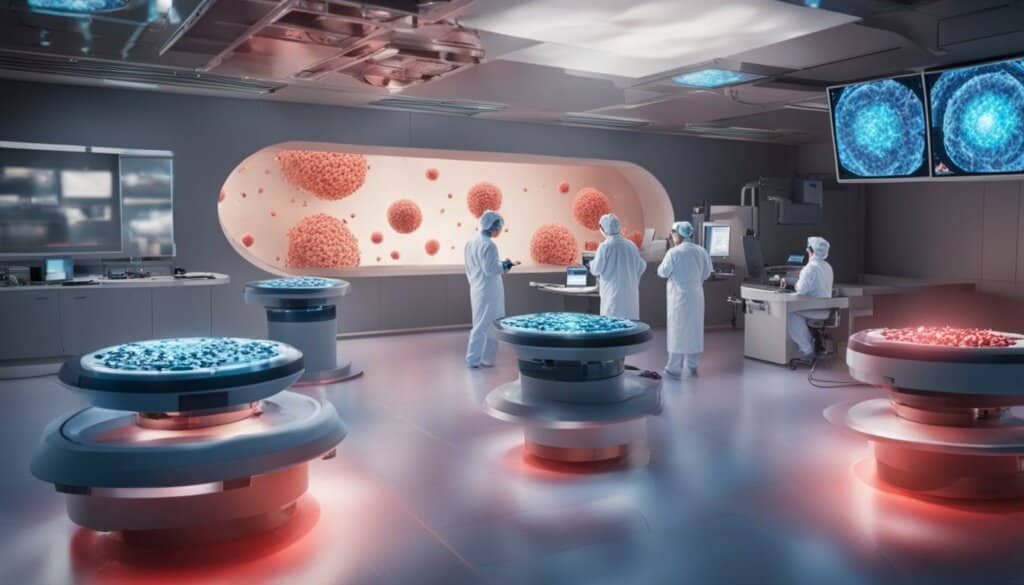
Conclusion
Nanotechnology is revolutionizing cancer treatment, offering breakthroughs in targeted drug delivery, improved radiation therapy, enhanced immunotherapy, and more effective gene therapy. With nanotechnology, we have the potential to transform cancer care, increasing treatment efficacy while reducing side effects. Ongoing research and development in this field continue to drive innovation and improve patient outcomes in the fight against cancer.
The ability of nanotechnology to selectively target and deliver therapies directly to cancer cells is a game-changer. It allows clinicians to administer chemotherapy, radiotherapy, and advanced immunotherapies directly to the tumor, minimizing damage to healthy tissues. Furthermore, nanotechnology-based interventions can guide surgical resection of tumors, improving the accuracy of surgical procedures.
By leveraging nanotechnology, we can enhance the effectiveness and safety of cancer treatments. Nanoparticles enable more precise drug delivery, allowing for lower doses and reduced toxicity. They can also enhance radiation therapy and sensitize cancer cells to treatment. Additionally, nanotechnology-based approaches facilitate the delivery of immunostimulatory molecules and play a crucial role in gene therapy for targeting previously “undruggable” cancer proteins.
The ongoing advancements in nanotechnology for cancer treatment hold great promise for the future. As we deepen our understanding of the potential risks and ensure safe and responsible usage, nanotech breakthroughs will continue to shape the landscape of cancer care, benefiting patients worldwide.
FAQ
How can nanotechnology enhance chemotherapy for cancer treatment?
Nanotechnology can improve chemotherapy by selectively targeting and delivering anticancer drugs to tumor tissues, reducing systemic toxicities, and increasing the therapeutic index of drugs. It allows for the selective delivery of nanotherapeutic platforms to tumors through passive targeting or external/internal trigger mechanisms.
In what ways can nanotechnology improve radiotherapy for cancer treatment?
Nanotechnology can enhance radiotherapy by utilizing nanoscale materials to increase the efficacy of conventional radiation therapy. Nanoparticles can enhance the effects of radiation, reduce dosage and toxicity to surrounding tissue, and enable localized drug release and sensitization of cancer cells to radiotherapy. Nanomaterials can also generate cytotoxic reactive oxygen species for tumor destruction.
How does nanotechnology advance immunotherapy for cancer treatment?
Nanoparticles can enhance the effectiveness of immunotherapy by delivering immunostimulatory or immunomodulatory molecules in combination with chemo- or radiotherapy. They can capture antigens shed from tumors for nanoparticle-based vaccines, improve immune cell sorting and imaging, and enhance tumor cell death, antigen presentation, T cell activation, and the delivery of pro-immune and pro-inflammatory agents to tumors and tumor microenvironments.
In what ways does nanotechnology deliver gene therapy for cancer treatment?
Nanotechnology enables the delivery of nucleic acids for gene therapy by encapsulating or conjugating small interfering RNAs (siRNAs), messenger RNAs (mRNAs), and microRNAs (miRNAs). This allows for more stable delivery and targeting of ‘undruggable’ cancer proteins. Nanotechnology in gene therapy opens up new possibilities for treating cancer.
How does nanotechnology contribute to early detection and diagnosis of cancer?
Nanoparticles and nano-devices can be used to develop advanced diagnostics for precise monitoring of patient response to therapy, optimizing treatment, and improving outcomes. Nanotechnology-based tools can detect cancer at an early stage, increasing the chances of successful treatment and revolutionizing cancer diagnosis.
How does nanotechnology play a role in cancer treatment?
Nanotechnology enables precise administration of therapies to cancerous cells and tissues, including chemotherapy, radiotherapy, immunotherapy, and gene therapy. It improves the safety and effectiveness of these treatments, guides surgical resection of tumors, and offers new clinical interventions for cancer patients.
What safety considerations are involved in nanotechnology cancer treatments?
While nanotechnology holds promise for improving cancer treatment, ensuring patient safety is crucial. Researchers are working towards a complete understanding of the potential risks and safe usage of nanotechnologies in cancer treatment to unlock its full potential and protect patients.
How is nanotechnology transforming the field of cancer treatment?
Nanotechnology offers advancements in targeted drug delivery, improved radiation therapy, enhanced immunotherapy, and more effective gene therapy. It has the potential to revolutionize cancer care by increasing treatment efficacy and reducing side effects. Ongoing research and development continue to drive innovation and improve patient outcomes in the fight against cancer.


